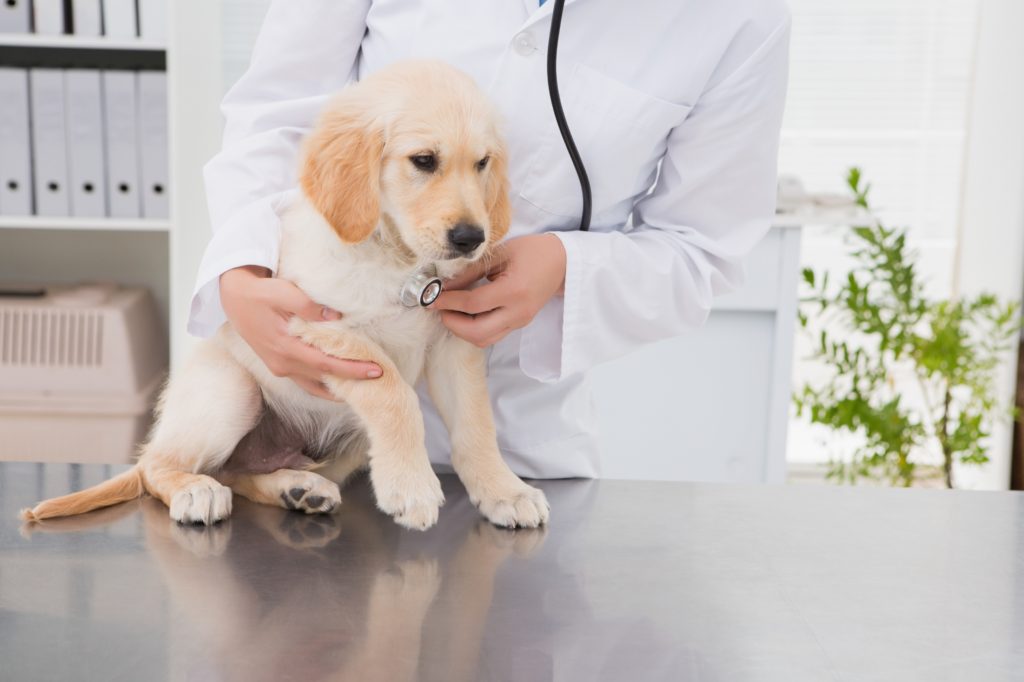Dogs hate the vets, right? It doesn’t have to be that way!
It’s not surprising that many dogs form bad associations with their veterinary practice. Their first visits are usually for injections (which sting) and they may be upset by other pets in the waiting room. I also wonder how the vets must smell to a dog …can they smell the blood from operations happening in theatre, do dogs leave scents which indicate they were sick, hurt, or afraid? How can you prepare your puppy or dog for vet visits, and how can you make their experiences as good as possible?

With a young puppy their first visits will hopefully be before their first fear period, but extra precautions may be needed with guarding breeds and terriers who may enter their first fear period as early as 7 weeks. Ideally, breeders should get puppies used to gentle handling from an early age; by using tasty food most puppies can get used to having their paws handled, being picked up, showing their bellies, and having their skin lifted (as though for an injection). With older dogs you may want to do some desensitisation work at home before going to the vets. Start by touching areas your dog likes and reward (you might like to use a clicker or a work like ‘good’ to mark the behaviour you want). Gradually move to areas the dog is not as happy with …if you are working on nail trimming you may need to break your training into very small chunks …touching the foot, touching the foot with nail clippers nearby, holding the foot, squeezing a toe, squeezing a toe while holding the clippers, clipping one nail … Don’t rush your dog, and if you see signs that he is uncomfortable stop and let him relax.
As a vet, areas I would like to see owners work on with their dogs would include foot handling (for nail clips, but also for IV drugs as we need to hold the lower leg to put a cannula in), eye and ear examinations, tooth and mouth examinations, tail handling (for checking anal glands, taking temperatures, and checking if bitches are in season), showing the belly, and having skin lifted (as we need to do for injections). I think teaching a dog to wear a muzzle is a great idea too; so many dogs are only forced into muzzles when they are already scared or painful and the muzzle soon becomes a signal that bad things are about to happen.
When you need to take your dog to the vet choose a time which means you won’t be rushed and arrive early so you can take your dog for a walk around (if appropriate). Bring really tasty treats to distract your dog or puppy and to reward good behaviour. Dog-safe peanut butter or squeezy cheese can be really useful as your dog can lick these off the consulting table! Once you have booked in, choose a quiet spot in the waiting room and avoid dogs which are lunging into your dog’s space, barking, or whining. Don’t let your dog be a nuisance either! Especially if you are sharing the waiting room with cats or rabbits.
When called into the consulting room let your vet know that you are training your dog or puppy and explain any areas which are still difficult. I find most puppies are easily distracted for their injections by some tasty food, and this can be surprisingly effective with older dogs too. If your dog can’t have food during the visit (perhaps he is staying in for an operation or has an upset stomach) try offering a toy to chew on.
After a real vet visit, which may have been unpleasant despite your best efforts, don’t stay away! I encourage owners of new dogs and puppies to come into the practice for regular weight checks, to have treats and cuddles from the reception team, and even to sit quietly in the waiting room before heading home. These neutral or pleasant experiences help a dog to be more relaxed in the veterinary clinic.
Some clinics may have nurses or vets with behavioural qualifications who can put together a specific desensitisation programme for you to follow.


